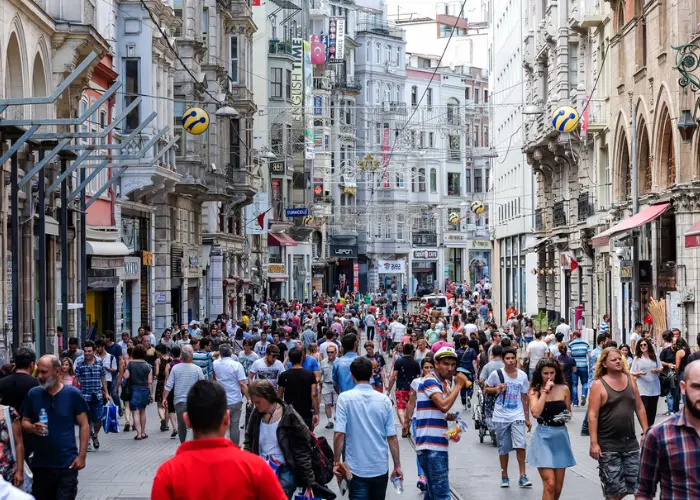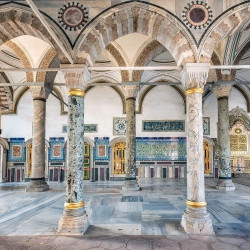Under the leadership of Mustafa Kemal Atatürk, Istanbul had a new identity during the republican period; a new chapter of the history of Istanbul started. Following the Ottoman Empire’s and its allies’ defeat in World War I, the National War of Independence lasted from 1919 to 1923. At the end of the war, the Republic of Turkey was established; Mustafa Kemal Atatürk, the commander-in-chief in the war of independence, was the new republic’s first president.
With the establishment of the Republic of Turkey, Istanbul has undergone many alterations in many ways. After the Ottoman Empire, which could not keep up with the needs of the era, and which lacked many qualities that other countries had and kept developing in the process of time, the new identity has led Istanbul to take a unique place in the stages of history.
In virtue of the modernization process, which Mustafa Kemal Atatürk gave great importance to, Istanbul has developed a distinct identity as a modern and global city. From an economic and cultural standpoint, Istanbul is the beating heart of modern Turkey. Thanks to Istanbul’s peerless historical heritage, Istanbul remains an important city, not only for Turkey but also in the eyes of the rest of the world.
Being home to many international political, cultural, fine arts, and sports organizations, Istanbul is rapidly ascending to the top of the world city rankings. Moreover, Istanbul, Turkey’s western getaway, has redefined its former status as an imperial capital by establishing itself as a world-class center for trade, tourism, business, and culture.
New Istanbul and the Republic of Turkey

Istanbul had a significant role in Westernization efforts; it was not only the center of attention for the country’s relationship with the West but also was a center for intellectual and popular development. Over the last two decades, Westernization has been the single powerful and influential criterion for determining Turkish society and its historical background.
With the foundation of the Republic of Turkey, the modern Turkish nobles desired to distinguish themselves as distinct in terms of their perception, education, and profession. Therefore, this gradually led to an influence on social life. Culture of music, dance, cinema, theater, clothes, sports, eating and drinking, entertainment, and more had their new identities with Westernization. These all have a special place in Istanbul, and it has superiority even though Ankara was the political center.
Istanbul’s Layout During Republican Period
The squares, which were used to introduce a new identity to the city, were one of the most important local structures that gave the city a modern identity. The construction of new squares in the city can be seen in the earliest years of the Republic of Turkey. Beyazıt Square, home to many historical structures, was created as a public open space in 1923-24, with a fountain and pool in the center. This was followed by the designation of Taksim Square as a terminal point that is the city’s symbol and center.
A renowned city planner named Henri Prost was the first person to design the early layout of the city for 15 years. Various stadiums, boulevards, and opera houses spread throughout the city are among his marks. This formed the first modern layout for the city, and from that point on, it never stopped growing and growing.
Istanbul has three bridges that connect Europe and Asia. The first one was built in 1973, and it took three years to finish construction. It was formerly called Boğaziçi Bridge, and it is now called 15 Temmuz Şehitler Bridge. The other two bridges, Fatih Sultan Mehmet Bridge and Yavuz Sultan Selim Bridge were built in 1988 and 2016, respectively. They are both named after prominent Sultans in the Ottoman Era. There were projects of other bridges before the Republic of Turkey, but they were not initiated during the times of the Ottoman Empire. Even Da Vinci had a project regarding a bridge to be built over Golden Horn, and it would reach over the Bosphorus.
Big Wave of New Residents

As the economy and reach of Istanbul extended over the Republic of Turkey, people living in Anatolian regions that are more rural than urban started to migrate to Istanbul. It was a huge and never-ending wave that brought both economic movements and a crisis in terms of residential areas as the number of apartments could not meet the needs of the newcomers. A great construction began to catch up with the fresh people. The size of the city doubled, tripled even, and the city stretched through the coastline on both continents. We should note that this still carries on, and Istanbul is ten times bigger than it was.
Now a Home To Millions
Sixteen million people live in Istanbul now, and it is the heart of the Republic of Turkey without a doubt. Millions of other people come here for business or tourist purposes. Yes, it is a crowded, buzzing city, but thinking about its history with all its glory, we believe it is just for Istanbul to be crowded. Home to various cultures, religions, and minorities; a place where art, history, culture, music, and people come together harmoniously. Istanbul still carries overall what it had seen in the past, and since the foundation of the Republic of Turkey, it is still being preserved.
Frequently Asked Question
When was the Republic of Turkey founded?
The republic of Turkey was founded in 1923.
Who was the urban architect of Istanbul?
The first urban architect of Istanbul was Henri Prost.
Why is Istanbul so important?
Istanbul is still important today because it is the center of culture, trade, tourism and art in Turkey.
How many bridges are there in Istanbul?
There are currently three bridges in Istanbul that connect the European and Asian sides.
 English
English  Spanish
Spanish  French
French  Arabic
Arabic  Bulgarian
Bulgarian  Chinese
Chinese  Croatian
Croatian  German
German  Greek
Greek  Hungarian
Hungarian  Indian
Indian  Indonesian
Indonesian  Italian
Italian  Japanese
Japanese  Korean
Korean  Macedonian
Macedonian  Persian
Persian  Portuguese
Portuguese  Romanian
Romanian  Russian
Russian  Taiwanese
Taiwanese  Urdu
Urdu 





